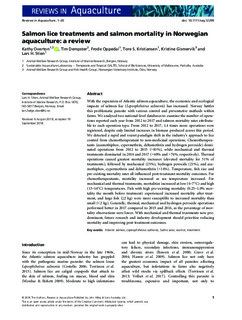| dc.description.abstract | With the expansion of Atlantic salmon aquaculture, the economic and ecological impacts of salmon lice (Lepeophtheirus salmonis) has increased. Norway battles this problematic parasite with various control and preventative methods within farms. We analysed two national‐level databases to examine the number of operations reported each year from 2012 to 2017 and salmon mortality rates attributable to each operation type. From 2012 to 2017, 1.4 times more operations were registered, despite only limited increases in biomass produced across this period. We detected a rapid and recent paradigm shift in the industry's approach to lice control from chemotherapeutant to non‐medicinal operations. Chemotherapeutants (azamethiphos, cypermethrin, deltamethrin and hydrogen peroxide) dominated operations from 2012 to 2015 (>81%), while mechanical and thermal treatments dominated in 2016 and 2017 (>40% and >74%, respectively). Thermal operations caused greatest mortality increases (elevated mortality for 31% of treatments), followed by mechanical (25%), hydrogen peroxide (21%), and azamethiphos, cypermethrin and deltamethrin (<14%). Temperature, fish size and pre‐existing mortality rates all influenced post‐treatment mortality outcomes. For chemotherapeutants, mortality increased as sea temperature increased. For mechanical and thermal treatments, mortalities increased at low (4–7°C) and high (13–16°C) temperatures. Fish with high pre‐existing mortality (0.25–1.0% mortality the month before treatment) experienced increased mortality after treatment, and large fish (≥2 kg) were more susceptible to increased mortality than small (<2 kg). Generally, thermal, mechanical and hydrogen peroxide operations performed better in 2017 compared to 2015 and 2016, as the percentage of mortality observations were lower. With mechanical and thermal treatments now predominant, future research and industry development should prioritise reducing mortality and improving post‐treatment outcomes. | nb_NO |
